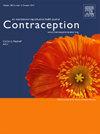经皮神经电刺激(Tens)用于控制第一胎程序性流产期间的疼痛:一项盲法随机对照试验
IF 2.8
2区 医学
Q1 OBSTETRICS & GYNECOLOGY
引用次数: 0
摘要
方法 这是一项双盲、整群随机优效试验(IRB 批准,NCT05320432),比较了 TENS(置于后方,T10-L1 和 S2-S4)和假TENS 在第一胎人工流产术中的止痛效果。我们在两家门诊诊所招募了妊娠不足 12 周、讲英语或西班牙语且未接受镇静剂治疗的孕妇。主要结果是通过视觉模拟量表(VAS,100 毫米)显示最大宫颈扩张器通过时的自述疼痛。我们计划招募 70 名患者,以显示中位疼痛评分有 15 毫米的差异(80% 功率,α = 0.05)。结果在 2023 年 1 月至 2024 年 3 月期间,我们招募了 70 名参与者。各组的基线人口统计学特征均衡:中位数(范围)妊娠持续时间为 6.8(5.1-11.8)周,35.7% 为单胎。TENS 组和假阴道组报告的最大扩张器通过时的疼痛中位数(范围)分别为 44 毫米(0-88)和 50 毫米(0-96)(P=0.56)。我们没有发现在任何收集的时间点,包括放置腱膜、宫颈旁阻滞、抽吸或恢复时,疼痛中位数存在差异。主动接受 TENS 治疗组更有可能表示会向他人推荐这种疼痛控制方法(94 毫米 vs 73 毫米,P=0.01)。更多接受 TENS 装置的参与者正确识别了他们的组别分配(91.4% vs 63.6%,p<0.001)。结论虽然我们没有证明手术过程中疼痛的差异,但 TENS 是一种非药物替代方法,可能会改善子宫吸引术中患者的体验。本文章由计算机程序翻译,如有差异,请以英文原文为准。
TRANSCUTANEOUS ELECTRICAL NERVE STIMULATION (TENS) FOR PAIN CONTROL DURING FIRST-TRIMESTER PROCEDURAL ABORTION: A BLINDED RANDOMIZED CONTROLLED TRIAL
Objectives
We aimed to evaluate the efficacy of transcutaneous electrical nerve stimulation (TENS) to manage pain during first-trimester procedural abortion for those not eligible for or otherwise foregoing sedation.
Methods
This is a double-blinded, block-randomized superiority trial (IRB approved, NCT05320432) comparing TENS (placed posteriorly, T10-L1 and S2-S4) to sham for pain management during first-trimester procedural abortion. We enrolled pregnant people less than 12 weeks gestation, English- or Spanish-speaking at two outpatient clinics who were not receiving sedation. The primary outcome was self-reported pain by visual analog scale (VAS, 100 mm) with passage of largest cervical dilator. We planned to enroll 70 patients to show a 15 mm difference in median pain score (80% power, α = 0.05).
Results
Between January 2023 and March 2024, we enrolled 70 participants. Baseline demographics were balanced between groups: median (range) gestational duration 6.8 (5.1-11.8) weeks, 35.7% nulliparous. Median (range) reported pain with passage of largest dilator was 44mm (0–88) and 50mm (0–96) in the TENS and sham groups, respectively (p=0.56). We did not find a difference in median pain at any collected time point including placement of tenaculum, paracervical block, aspiration, or recovery. The active TENS group was more likely to say they would recommend this method of pain control to others (94mm vs 73mm, p=0.01). More participants receiving TENS unit correctly identified their group allocation (91.4% vs 63.6%, p<0.001).
Conclusions
While we did not demonstrate a difference in pain during the procedure, TENS is a non-pharmacologic alternative that may improve patient experience during uterine aspiration.
求助全文
通过发布文献求助,成功后即可免费获取论文全文。
去求助
来源期刊

Contraception
医学-妇产科学
CiteScore
4.70
自引率
17.20%
发文量
211
审稿时长
69 days
期刊介绍:
Contraception has an open access mirror journal Contraception: X, sharing the same aims and scope, editorial team, submission system and rigorous peer review.
The journal Contraception wishes to advance reproductive health through the rapid publication of the best and most interesting new scholarship regarding contraception and related fields such as abortion. The journal welcomes manuscripts from investigators working in the laboratory, clinical and social sciences, as well as public health and health professions education.
 求助内容:
求助内容: 应助结果提醒方式:
应助结果提醒方式:


